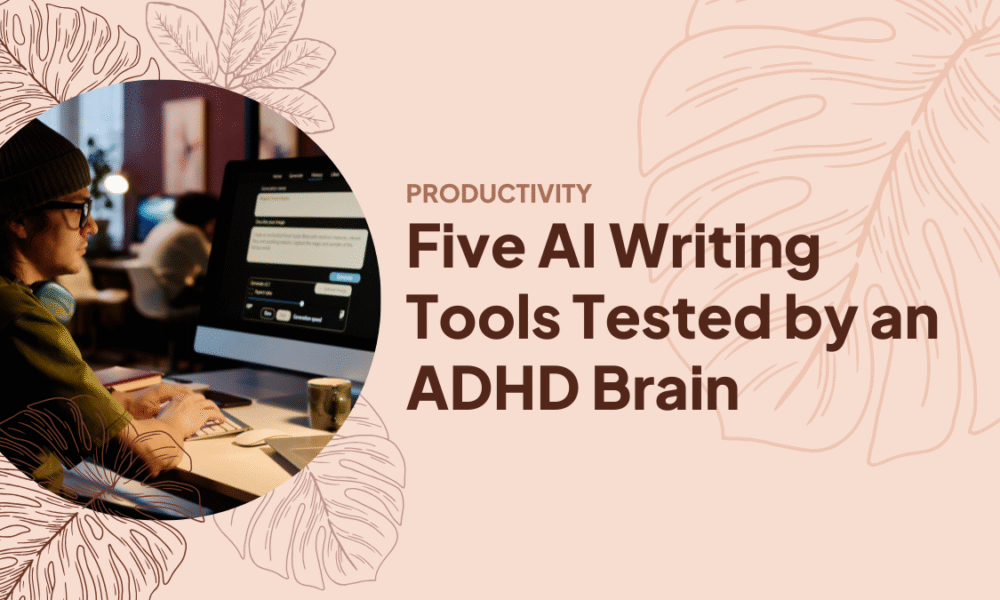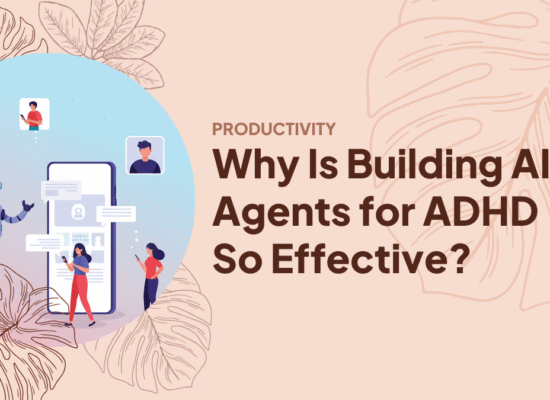Table of Contents
- Pressmaster AI’s adaptive mode captures authentic voice better than competitors by interviewing users rather than generating from prompts
- Most AI writing tools produce “word salad” with overly sophisticated vocabulary, but voice authenticity matters more than technical features
- Test AI tools with personal writing samples like self-introductions to evaluate authentic voice capture over generic content generation
My ADHD brain jumps from idea to idea faster than I can type.
One moment I’m writing about content strategy, the next I’m scribbling down a random thought about hobby psychology. Before AI writing tools, I spent hours creating mind maps just to wrangle my scattered thoughts into coherent articles.
So when AI writing assistants promised to understand my voice and organize my ideas, I had to test that claim.
I tested five major AI writing tools over two years: Copy AI, Writesonic, StoryChief, Jasper, and Pressmaster AI. My criteria wasn’t features or pricing.
I wanted to know which tool could take my chaotic ADHD thought patterns and turn them into authentic content that sounded like me.
Here’s what I discovered.
The Voice Authenticity Problem
Most AI writing tools produce what I call “word salad.”
You know the signs. Overly sophisticated vocabulary that screams “AI generated.” Sentences that are technically correct but emotionally hollow. Content that reads like a corporate press release instead of human conversation.
As someone who transforms technical marketing elements into human-centered narratives, this authenticity gap frustrated me immediately.
The real test wasn’t whether these tools could write grammatically correct content. It was whether they could capture the nuances of how I actually think and communicate.
For my ADHD brain, this meant something specific: could the tool take my tangential, interconnected thoughts and weave them into coherent narratives without losing my natural voice?
1. Copy AI

Copy AI was my first experiment with AI writing tools.
The interface felt intuitive, and the template variety impressed me initially. I could choose from dozens of content formats, from social media posts to long-form articles.
But when I fed it samples of my writing and tried to generate content about my experiences, the output felt generic.
The tool struggled with my conversational tone and tendency to use specific examples rather than broad generalizations. Every piece it generated required extensive editing to sound like something I would actually say.
Copy AI worked fine for basic content creation, but it never learned to think like me.
2. Writesonic

Writesonic impressed me with its technical capabilities.
The SEO integration was solid, and it could generate content quickly across multiple formats. For businesses focused purely on content volume, I could see the appeal.
But again, the voice authenticity problem persisted.
When I tested it with personal topics like my ADHD experiences or specific client challenges, the output read like a textbook rather than a personal narrative. The tool could mimic professional writing styles but couldn’t capture the conversational, empathetic tone that defines my brand.
Writesonic felt like hiring a technically skilled writer who had never met me.
3. StoryChief

StoryChief’s strength lay in its collaborative features and content distribution capabilities.
The platform excelled at managing content workflows and publishing across multiple channels. For teams managing large content operations, these features solve real problems.
However, the AI writing component still struggled with voice authenticity.
Like the previous tools, StoryChief could produce technically sound content but couldn’t capture the specific way I connect technical concepts to human experiences. The output required significant rewriting to match my natural communication style.
StoryChief worked better as a content management system than as a voice-authentic writing assistant.
4. Jasper

Jasper offered the most sophisticated training capabilities I had encountered.
I could upload brand guides, specify dos and don’ts, and create detailed knowledge bases similar to custom GPT training. The setup process felt comprehensive and promising.
Initially, Jasper’s output quality impressed me. The tool seemed to understand my preferences better than previous options.
But consistency became the problem.
Despite extensive training, Jasper would occasionally revert to “word salad” mode. I’d get content with unnecessarily complex vocabulary and formal sentence structures that clearly marked it as AI-generated.
The editing process took longer because I had to identify and replace these artificial-sounding elements while preserving the useful content structure.
Jasper felt close to breakthrough but never quite achieved reliable voice authenticity.
5. Pressmaster AI

Pressmaster AI changed everything for me.
The setup process involved uploading writing samples and completing an interview about my website, my background, and my communication style. Similar to Jasper’s training, but something about the implementation felt different.
The breakthrough came when I tested Pressmaster’s adaptive mode.
Instead of generating content from prompts, the tool interviewed me about my topic. I could have what I called a “pseudo TED talk” in my home office, speaking naturally about my ideas while the AI organized my thoughts into coherent structure.
The output quality matched my peak creative writing.
When I wrote about my ADHD experiences with hobbies, Pressmaster captured not just the information but the emotional undertones and conversational flow that make my content authentic.
As Elizabeth Gilbert writes in Big Magic, ideas can fly away if you don’t capture them quickly. Pressmaster became my idea capture system, preventing those creative sparks from escaping to someone else’s brain.
The tool felt like an extension of my thinking process rather than a separate writing assistant.
The Technical Reality Check
None of these tools handle technical SEO automatically.
This surprised many clients who expected AI writing tools to optimize content for search engines natively. While AI-assisted blog writing tools increase organic traffic by 120% within 6 months, this happens through improved content creation efficiency, not automatic SEO optimization.
I had to develop custom prompts within each tool’s chat interface to handle SEO elements like key takeaways, FAQ sections, and generative engine optimization.
Pressmaster’s web citations feature helps identify authoritative links, but I still verify relevance manually. The tool accelerates research but doesn’t replace strategic thinking.
This technical limitation actually reinforced my preference for Pressmaster. Since I needed to add SEO elements anyway, I prioritized authentic voice capture over built-in optimization features.
The ROI Reality
Time savings proved significant across all tools, but quality consistency varied dramatically.
With my old manual process, creating a comprehensive article took 4-6 hours including research, outlining, writing, and optimization. Most Pressmaster users go from raw ideas to polished content in under 5-10 minutes, and my experience confirms this efficiency gain.
But efficiency means nothing if the output requires extensive rewriting.
Copy AI, Writesonic, and StoryChief saved time on first drafts but cost time in editing. Jasper performed better but inconsistently. Only Pressmaster delivered consistent quality that required minimal editing.
The grammar correction moment illustrates this perfectly. When I caught myself saying “SEO optimization” during our conversation, that natural correction reflects how I actually communicate. Pressmaster captures these personality quirks that make content authentic.
My Google Search Console data shows steady improvement since implementing Pressmaster, though algorithm changes still cause fluctuations that no AI tool can prevent.
The Voice Capture Test
For anyone evaluating these tools, I recommend a specific authenticity test.
Feed each tool a personal writing sample. Not marketing copy or professional content, but something that reveals your natural voice. Your LinkedIn About section, a personal essay, or even how you introduce yourself at networking events.
Then ask the tool to write about a topic you care deeply about.
The output will reveal whether the AI captured your thought patterns, emotional undertones, and communication style, or simply produced technically correct content in a generic voice.
This test eliminated four tools quickly and identified Pressmaster as the clear winner for voice authenticity.
The Human Element Warning
The biggest mistake I see marketers making is over-relying on AI tools.
Yes, these tools save time and help overcome creative blocks. But 71.7% of content marketers use AI for outlining, 68% for content ideation, and 57.4% for drafting content, suggesting widespread adoption without strategic thinking.
Convenience can flush away your creative spark.
People crave authenticity amid the surge of AI-generated content. Platforms increasingly restrict monetization of AI-created content, recognizing audience preference for human connection.
The most effective approach treats AI as a cognitive organizing tool, not a replacement for human insight and creativity.
My ADHD brain benefits enormously from Pressmaster’s ability to capture and organize scattered thoughts. But the ideas, experiences, and perspectives that make content valuable still come from me.
The Future of Authentic AI Writing Tools
Voice authenticity will become the primary differentiator among AI writing tools.
Technical features like SEO optimization, template variety, and collaboration capabilities matter less than the tool’s ability to capture and maintain individual communication styles.
Pressmaster’s adaptive mode points toward this future. Instead of generating content from prompts, the tool interviews users to understand their thinking process and natural expression patterns.
This approach solves the fundamental problem with AI writing: the gap between technical competence and authentic voice.
For content marketers, the question isn’t whether to use AI writing tools. It’s which tool can amplify your authentic voice rather than replace it with generic alternatives.
After testing five major options, I found only one that passes the authenticity test consistently.
Your mileage may vary, but the testing methodology remains the same: prioritize voice capture over feature lists, and never sacrifice authenticity for convenience.
The writing part of your brain deserves better than word salad.
Ready to Transform Your Content Creation?
Frequently Asked Questions
Which AI writing tool works best for ADHD brains?
Pressmaster AI’s adaptive mode excels for entrepreneurs with ADHD because it captures scattered thoughts through interview-style interaction. Unlike other tools that require structured prompts, it organizes tangential ideas into coherent narratives while maintaining your authentic voice.
How do AI writing tools handle personal content creation?
AI writing tools excel when creating content about ADHD-friendly hobbies and personal experiences. Pressmaster captured both the information and conversational flow when I wrote about my ADHD hobby experiences, maintaining authenticity throughout.
Are AI writing tools effective for neurodivergent users?
AI writing tools are particularly effective for people with ADHD and autism who struggle with organizing thoughts or executive function. Pressmaster’s interview approach reduces cognitive load by asking targeted questions rather than requiring users to structure their ideas independently.
Maria is an accomplished digital marketing professional, specializing in content marketing and SEO. She's a neurodivergent who strives to raise awareness, and overcome the stigma that envelopes around mental health.






